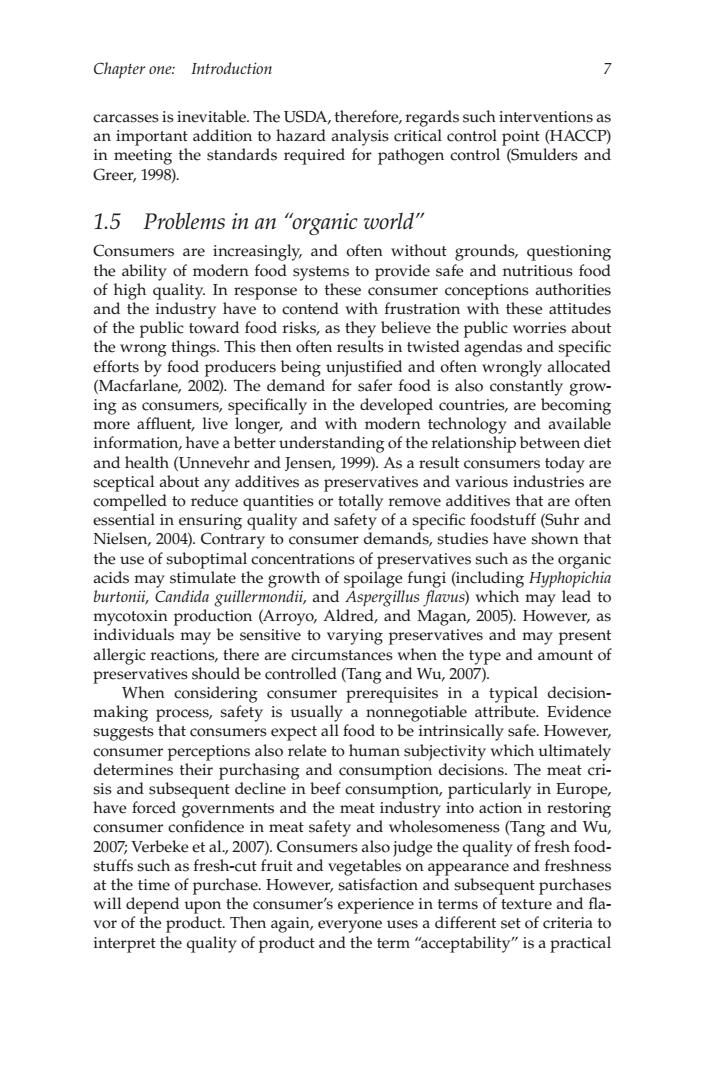正在加载图片...

Chapter one:Introduction carcasses is inevitable.The USDA,therefore,regards such interventions as an important addition to hazard analysis critical control point(HACCP) in meeting the standards required for pathogen control (Smulders and Greer,1998). 1.5 Problems in an "organic world" Consumers are increasingly,and often without grounds,questioning the ability of modern food systems to provide safe and nutritious food of high quality.In response to these consumer conceptions authorities and the industry have to contend with frustration with these attitudes of the public toward food risks,as they believe the public worries about the wrong things.This then often results in twisted agendas and specific efforts by food producers being unjustified and often wrongly allocated (Macfarla ne,2002).The safer food is alsc cons loped countries,are be ly grow ing as c more affluent,live longer,and with deve mo tec nnology and availa information,have a better understanding of the relationship between diet and health(Unnevehr and Jensen,1999).As a result consumers today are sceptical about any additives as preservatives and various industries are compelled to reduce quantities or totally remove additives that are often essential in ensuring quality and safety of a specific foodstuff(Suhr and Nielsen,2004).Contrary to consumer demands,studies have shown that the use of sub pti atior s of preservativ such as the nay stin the growth o spoilag fungi(includ ng Hyphop Aspergil )whi h may lead to mycotoxin production(Arroyo,Aldred,and Magan,2005).However,as individuals may be sensitive to varying preservatives and may present allergic reactions,there are circumstances when the type and amount of preservatives should be controlled(Tang and Wu,2007). When considering consumer prer quisites in a typical decision- making safety is usually ute.Evidenc expect ali i food to be negotiable attr sically fe.However consumer perceptions also relate to human subjectivity which ultimately determines their purchasing and consumption decisions.The meat cri- sis and subsequent decline in beef consumption,particularly in Europe, have forced governments and the meat industry into action in restoring consumer confidence in meat safety and wholesomeness (Tang and wu 2007:Verbeke et al..2007).Consumers also iudge the quality of fresh food- stuffs such as fresh-cut fruit and y ance and freshne at the time will d f purchase Howeve Pa sub equent purchas pend e consumer's experience in ms of t and vor of the product.Then again,everyone uses a different set of criteria interpret the quality of product and the term "acceptability"is a practical Chapter one: Introduction 7 carcasses is inevitable. The USDA, therefore, regards such interventions as an important addition to hazard analysis critical control point (HACCP) in meeting the standards required for pathogen control (Smulders and Greer, 1998). 1.5 Problems in an “organic world” Consumers are increasingly, and often without grounds, questioning the ability of modern food systems to provide safe and nutritious food of high quality. In response to these consumer conceptions authorities and the industry have to contend with frustration with these attitudes of the public toward food risks, as they believe the public worries about the wrong things. This then often results in twisted agendas and specific efforts by food producers being unjustified and often wrongly allocated (Macfarlane, 2002). The demand for safer food is also constantly growing as consumers, specifically in the developed countries, are becoming more affluent, live longer, and with modern technology and available information, have a better understanding of the relationship between diet and health (Unnevehr and Jensen, 1999). As a result consumers today are sceptical about any additives as preservatives and various industries are compelled to reduce quantities or totally remove additives that are often essential in ensuring quality and safety of a specific foodstuff (Suhr and Nielsen, 2004). Contrary to consumer demands, studies have shown that the use of suboptimal concentrations of preservatives such as the organic acids may stimulate the growth of spoilage fungi (including Hyphopichia burtonii, Candida guillermondii, and Aspergillus flavus) which may lead to mycotoxin production (Arroyo, Aldred, and Magan, 2005). However, as individuals may be sensitive to varying preservatives and may present allergic reactions, there are circumstances when the type and amount of preservatives should be controlled (Tang and Wu, 2007). When considering consumer prerequisites in a typical decisionmaking process, safety is usually a nonnegotiable attribute. Evidence suggests that consumers expect all food to be intrinsically safe. However, consumer perceptions also relate to human subjectivity which ultimately determines their purchasing and consumption decisions. The meat crisis and subsequent decline in beef consumption, particularly in Europe, have forced governments and the meat industry into action in restoring consumer confidence in meat safety and wholesomeness (Tang and Wu, 2007; Verbeke et al., 2007). Consumers also judge the quality of fresh foodstuffs such as fresh-cut fruit and vegetables on appearance and freshness at the time of purchase. However, satisfaction and subsequent purchases will depend upon the consumer’s experience in terms of texture and flavor of the product. Then again, everyone uses a different set of criteria to interpret the quality of product and the term “acceptability” is a practical